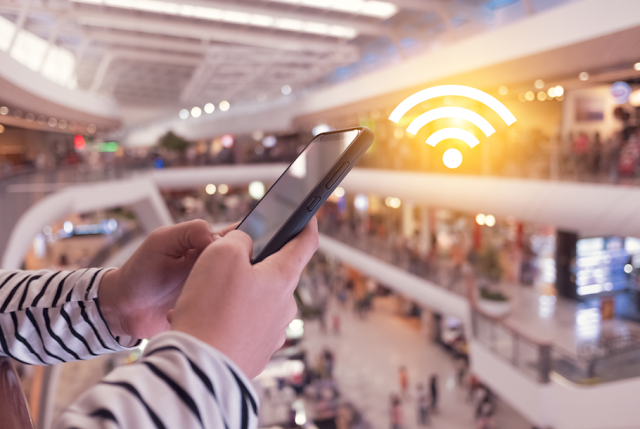Public Wi-Fi networks can be convenient for staying connected on the go, but they also come with several security risks. Here are some of the risks associated with public Wi-Fi and steps you can take to protect yourself:
Risks of Public Wi-Fi:
Data Interception: Hackers can intercept data transmitted over public Wi-Fi networks. This includes personal information, login credentials, and sensitive data.
Man-in-the-Middle Attacks: Attackers can position themselves between you and the network, intercepting and potentially altering the data you send and receive.
Rogue Hotspots: Cybercriminals can set up rogue Wi-Fi hotspots with names that resemble legitimate ones, tricking users into connecting to them and compromising their data.
Malware Distribution: Some public networks may be compromised or used to distribute malware to connected devices.
Session Hijacking: Attackers can hijack your online sessions, gaining access to your accounts and potentially carrying out malicious activities on your behalf.
How to Protect Yourself on Public Wi-Fi:
Use a VPN: A Virtual Private Network (VPN) encrypts your internet traffic, making it difficult for hackers to intercept your data. Ensure you use a reputable VPN service.
Turn Off Sharing: Disable file and printer sharing, as well as public folder sharing, to prevent unauthorized access to your device.
Choose Trusted Networks: Whenever possible, use known and trusted Wi-Fi networks. Avoid connecting to open or unsecured networks.
Forget Networks After Use: After you’re done with a public network, disconnect and make sure your device forgets the network so it doesn’t automatically reconnect.
Enable Firewall: Activate your device’s built-in firewall to add an extra layer of protection against incoming threats.
Use HTTPS: Ensure websites you visit use HTTPS, which encrypts data transmitted between your device and the website. You can use browser extensions like “HTTPS Everywhere” to enforce this.
Keep Software Updated: Regularly update your operating system, antivirus software, and applications to patch known vulnerabilities.
Enable Two-Factor Authentication (2FA): Whenever possible, enable 2FA on your online accounts. This adds an extra layer of security, even if your login credentials are compromised.
Use Secure Hotspots: If you must use public Wi-Fi, prefer those provided by reputable establishments like coffee shops, hotels, or airports, as they are more likely to have security measures in place.
Use a Mobile Hotspot: Consider using your smartphone as a mobile hotspot, which is often more secure than public Wi-Fi networks. Be mindful of your data usage, though.
Beware of Phishing: Be cautious when clicking on links or entering login credentials on public networks. Always verify the authenticity of the network and the websites you visit.
Monitor Your Device: Keep an eye on your device for any unusual activities or connections. Disconnect from the network if you notice anything suspicious.
By taking these precautions, you can significantly reduce the risks associated with using public Wi-Fi and protect your personal information and online security.
Additional steps and tips to further enhance your protection while using public Wi-Fi:
Use a Secure DNS: Configure your device to use a secure DNS resolver, such as Google DNS (8.8.8.8 and 8.8.4.4) or Cloudflare DNS (1.1.1.1). This can help protect you from malicious websites and DNS-based attacks.
Disable Auto-Connect: Turn off the automatic connection feature on your device for Wi-Fi networks. This ensures that you manually choose and connect to networks, reducing the risk of connecting to rogue hotspots.
Regularly Review Your Accounts: Periodically review your online accounts for any unauthorized activity. If you notice anything unusual, take immediate action to secure your accounts and change passwords.
Use a Strong, Unique Password: Ensure that your device and online accounts have strong, unique passwords. Avoid using the same password for multiple accounts. Consider using a password manager to help you create and manage strong passwords.
Keep Wi-Fi and Bluetooth Off When Not in Use: Disable Wi-Fi and Bluetooth on your device when you’re not actively using them. This prevents your device from automatically connecting to open or unsecured networks or being susceptible to Bluetooth attacks.
Be Cautious with Public Computers: If you’re using a public computer, avoid accessing sensitive accounts or entering personal information. Public computers may have malware or keyloggers installed.
Educate Yourself: Stay informed about the latest security threats and best practices for online safety. Knowledge is a powerful tool in protecting yourself from cyberattacks.
Consider a Mobile Data Plan: In situations where you frequently need internet access on the go, consider having a mobile data plan with a trusted carrier. This allows you to rely less on public Wi-Fi networks.
Monitor Your Financial Statements: Regularly review your bank and credit card statements for any unauthorized transactions. Report any discrepancies to your financial institution immediately.
Backup Your Data: Regularly back up your data to a secure location, such as an external hard drive or a cloud storage service. In case your device is compromised, you won’t lose critical information.
Remember that while these steps can significantly improve your security on public Wi-Fi, no method is completely foolproof. It’s essential to remain vigilant and use a combination of security practices to protect yourself effectively. Public Wi-Fi networks, especially open ones, should be treated with caution, and sensitive activities like online banking should ideally be performed on more secure, private networks.
Of course, here are a few more tips and considerations to help you stay secure when using public Wi-Fi:
Use Multi-Factor Authentication (MFA): Enable MFA wherever possible, not just for your online accounts but also for access to your devices. MFA requires a second form of authentication, such as a temporary code sent to your phone, making it much harder for unauthorized users to gain access.
Regularly Update Your Device: Keeping your device’s operating system, apps, and security software up to date is crucial. Updates often include security patches that fix vulnerabilities that hackers might exploit.
Consider a Guest Network: If you have a home network, set up a separate guest network for visitors. This keeps your primary network more secure by segregating it from potentially vulnerable devices.
Use WPA3 Encryption: When connecting to Wi-Fi networks, prioritize those that use WPA3 encryption over older standards like WPA2 or WEP. WPA3 offers stronger security protocols.
Turn Off Wi-Fi When Not in Use: If you’re not actively using Wi-Fi on your device, it’s a good practice to turn it off. This prevents your device from automatically seeking and connecting to open networks.
Use App-Specific Security: Some apps, like messaging and email clients, offer additional security features. For example, you can enable end-to-end encryption in messaging apps to protect your conversations.
Consider a Hardware Firewall: In addition to software firewalls, you can use a hardware firewall or a travel router with built-in security features when using public Wi-Fi frequently. These devices add an extra layer of protection.
Report Suspicious Activity: If you suspect that a public Wi-Fi network is compromised or have witnessed any suspicious activity, inform the network administrator or the establishment providing the Wi-Fi service. They can take appropriate actions to investigate and secure the network.
Limit Automatic Network Connections: Disable auto-connect settings on your device, as it can connect to previously used networks without your consent. Manually select trusted networks when connecting.
Practice Safe E-Browsing: Be cautious of the websites you visit while on public Wi-Fi. Avoid accessing sensitive or confidential information if possible. If you must, ensure you’re using secure connections (HTTPS) and log out when finished.
Secure Your Mobile Device: Mobile devices, such as smartphones and tablets, are often more vulnerable due to their portability. Set up security features like PINs, biometric authentication, and remote tracking/erasing capabilities in case your device is lost or stolen.
By following these additional steps and staying vigilant, you can significantly reduce the risks associated with using public Wi-Fi networks and protect your data and privacy while staying connected on the go.

